|
|
|
|
|
Oil On
Canvas, Real Flavor of Old Masters
|
|

|
ARTWORKS
INDEX
A B C D E F G H I J K L M N O P Q R S T U V W X Y Z |
ARTISTS
INDEX
A B C D E F G H I J K L M N O P Q R S T U V W X Y Z |
|
|
| | |
|
|
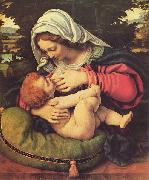 |
Andrea Solario -- Click Here
|
|
Andrea Solari (also Solario) (1460 in Milano - 1524) was an Italian Renaissance painter. He was initially named Andre del Gobbo, but more confusingly as Andrea del Bartolo a name shared with two other Italian painters, the 14th Century Siennese Andrea di Bartolo, and the 15th Century Florentine Andrea di Bartolo. |
|
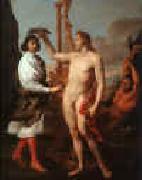 |
Andrea Sacchi -- Click Here
|
|
1559-1661
Italian
Andrea Sacchi Gallery
As a young man, Sacchi had worked under Cortona in Castel Fusano (1627-1629). But in a set of public debates later developed in the Roman Artist's Guild, Accademia di San Luca, he strongly criticized Cortona's exuberance. In particular, Sacchi advocated that since a unique, individual expression needs to be assigned to each figure in a composition, a painting should not consist of more than about ten figures. In a crowded composition, the figures would be deprived of individuality, and thus cloud the particular meaning of the piece. In some ways this is a reaction against the zealous excess of crowds in paintings by men such as Zuccari of the prior generation, and by Cortona among his contemporaries. Simplicity and unity were essential to Sacchi. Cortona argued that large paintings were more like an epic, that could avail themselves of multiple subplots. The encrustation of a painting with excess decorative details, including melees of crowds, would represent "wall-paper" art rather than focused narrative. Among the partisan's of Sacchi's argument for simplicity and focus were his friends, the sculptor Algardi and painter Poussin.
The controversy was however less pitched than some suggest, and also involved the dissatisfaction that Sacchi and Albani, among others, shared regarding the artistic depiction of low or genre subjects and themes, such as preferred by the Bamboccianti and even the Caravaggisti. They felt that high art should focus on exalted themes- biblical, mythologic, or from classic history.
Sacchi, who worked almost always in Rome, left few pictures visible in private galleries. He had a flourishing school: Poussin and Carlo Maratta were younger collaborators or pupils. In Maratta's large studio, Sacchi's preference for grand manner style would find pre-eminence among Roman circles for decades to follow. But many others worked under him or his influence including Luigi Garzi, Francesco Lauri, Andrea Camassei and Giacinto Gimignani. Sacchi's own illegitimate son Giuseppe, died young after giving very high hopes.
Sacchi died at Nettuno in 1661. |
|
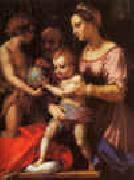 |
Andrea del Sarto -- Click Here
|
|
b.July 16, 1486, Florence
d.Sept. 28, 1530, Florence
Italian Andrea del Sarto Galleries
Andrea del Sarto (1486 ?C 1531) was an Italian painter from Florence, whose career flourished during the High Renaissance and early-Mannerism. Though highly regarded by his contemporaries as an artist "senza errori" (i.e., faultless), he is overshadowed now by equally talented contemporaries like Raphael.
Andrea fell in love with Lucrezia (del Fede), wife of a hatter named Carlo, of Recanati; the hatter dying opportunely, Andrea married her on 26 December 1512. She has come down to us in many a picture of her lover-husband, who constantly painted her as a Madonna and otherwise; even in painting other women he made them resemble Lucrezia. She was less gently handled by Giorgio Vasari, a pupil of Andrea, who describes her as faithless, jealous, and vixenish with the apprentices; her offstage character permeates Robert Browning's poem-monologue "Andrea del Sarto called the 'faultless painter'" (1855) .
He dwelt in Florence throughout the memorable siege of 1529, which was soon followed by an infectious pestilence. He caught the malady, struggled against it with little or no tending from his wife, who held aloof, and he died, no one knowing much about it at the moment, on 22 January 1531, at the comparatively early age of forty-three. He was buried unceremoniously in the church of the Servites. His wife survived her husband by forty years.
A number of paintings are considered to be self-portraits. One is in the National Gallery, London, an admirable half-figure, purchased in 1862. Another is at Alnwick Castle, a young man about twenty years, with his elbow on a table. Another youthful portrait is in the Uffizi Gallery, and the Pitti Palace contains more than one. |
|
 |
Alonso Sanchez Coello -- Click Here
|
|
Alonso Sachez Coello (1531/32 -August 8, 1588) was a portrait painter of the Spanish Renaissance and one of the pioneers of the great tradition of Spanish portrait painting.
Alonso Sachez Coello was born in Benifairode les Valls, near Valencia, and spent his childhood there, until the death of his father when he was around ten years old. He was educated in Portugal at his grandfather's home. Coello's years in Portugal and his family name of Portuguese origin led to a long-standing belief that he was in fact Portuguese. His grandfather (after whom he was named) was in the service of King John III of Portugal who sent the young painter to study with Anthonis Mor (also known as Antonio Moro) in Flanders around 1550. He was under the service of Antoine de Granville, bishop of Arras, learning from Mor. While studying in Flanders, Coello also spent time copying some of Titian's works. |
|
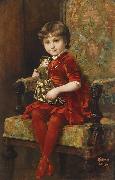 |
Alois Hans Schram -- Click Here
|
|
Alois Hans Schram
(1864 - 1919)
Alois Hans Schram was born in Vienna on August 20th. He was a painter and sculptor of historical subjects, figures, nudes, portraits, scenes with figures, genre scenes, local scenes, interiors with figures, landscapes with figures, urban landscapes, waterscapes and seascapes. |
|
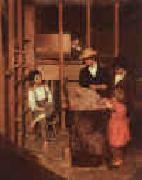 |
Allen Smith -- Click Here
|
|
1810-1890
Allen Smith Galleries |
|
|
|
|
|
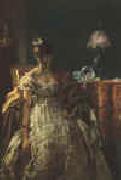 |
Alfred Stevens -- Click Here
|
|
1823-1906
Alfred Stevens Galleries
Flemish
Alfred Emile Stevens (May 11, 1823 - August 29, 1906) , Belgian painter, was born in Brussels.
El??gants sur les BoulevardsHis father, an old officer in the service of William I of the Netherlands, was passionately fond of pictures, and readily allowed his son to draw in the studio of François Navez, director of the Brussels Academy.
In 1844 Stevens went to Paris and worked under the instructing of Camille Roqueplan, a friend of his father's; he also attended the classes at the Ecole des Beaux-Arts, where Ingres was then professor. In 1849 he painted at Brussels his first picture, A Soldier in Trouble, and in the same year went back to Paris, where he definitely settled, and exhibited in the Salons. He then painted Ash-Wednesday Morning, Burghers and Country People finding at Daybreak the Body of a Murdered Gentleman, An Artist in Despair, and The Love of Gold.
Allegory of the Night
MSK, Oostende, BelgiumIn 1855 he exhibited at the Antwerp Salon a little picture called At Home, which showed the painter's bent towards depicting ladies of fashion. At the Great Exhibition in Paris, 1855, his contributions were remarkable, but in 1857 he returned to graceful female subjects, and his path thenceforth was clear before him. At the Great Exhibition of 1867 he was seen in a brilliant variety of works in the manner he had made his own, sending eighteen exquisite paintings; among them were the Lady in Pink (in the Brussels Gallery), Consolation, Every Good Fortune, Miss Fauvette, Ophelia, and India in Paris.
At the Paris International Exhibitions of 1878 and 1889, and at the Historical Exhibition of Belgian Art, Brussels, 1880, he exhibited The Four Seasons (in the Palace at Brussels), The Parisian Sphinx, The Japanese Mask, The Japanese Robe, and The Lady-bird (Brussels Gallery).
"Alfred Stevens is one of the race of great painters," wrote Camille Lemonnier, "and like them he takes immense pains with the execution of his work." The example of his finished technique was salutary, not merely to his brethren in Belgium, but to many foreign painters who received encouragement from the study of his method. The brother of Alfred Stevens, Joseph Stevens, was a great painter of dogs and dog life. See J. du Jardin, L'Art flamand; Camille Lemonnier, Histoire des beaux arts en Belgique.
|
|
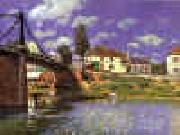 |
Alfred Sisley -- Click Here
|
|
French
1839-1899
Alfred Sisley Galleries
Alfred Sisley (October 30, 1839 ?C January 29, 1899) was an English Impressionist landscape painter who was born and spent most of his life in France. Sisley is recognized as perhaps the most consistent of the Impressionists, never deviating into figure painting or finding that the movement did not fulfill his artistic needs.
Sisley was born in Paris to affluent English parents; William Sisley was in the silk business, and his mother Felicia Sell was a cultivated music connoisseur. At the age of 18, Sisley was sent to London to study for a career in business, but he abandoned it after four years and returned to Paris. Beginning in 1862 he studied at the atelier of Swiss artist Marc-Charles-Gabriel Gleyre, where he became acquainted with Fr??d??ric Bazille, Claude Monet, and Pierre-Auguste Renoir. Together they would paint landscapes en plein air (in the open air) in order to realistically capture the transient effects of sunlight. This approach, innovative at the time, resulted in paintings more colorful and more broadly painted than the public was accustomed to seeing. Consequently, Sisley and his friends initially had few opportunities to exhibit or sell their work. Unlike some of his fellow students who suffered financial hardships, Sisley received an allowance from his father??until 1870, after which time he became increasingly poor. Sisley's student works are lost. His earliest known work, Lane near a Small Town is believed to have been painted around 1864. His first landscape paintings are sombre, coloured with dark browns, greens, and pale blues. They were often executed at Marly and Saint-Cloud. |
|
 |
Alfred Seifert -- Click Here
|
|
(September 6, 1850 Praskolesy, Bohemia - February 6, 1901, Munich, Germany) was a Czech-German painter, famous for his female portraits.
He was born in Praskolesy (present-day Czech Republic) but within a few months, his family moved to nearby Hořovice.
As a child, he fell seriously ill, could not walk for four years and spent two years in an orthopedic institution. Instead of playing, he started to draw pictures and his artistic talent soon started to emerge. His first teachers were Karel Werbs, inspector of Estates Gallery at Prague Castle, and Alois Kirnig, landscape painter. |
|
 |
Alfred Sacheverell Coke -- Click Here
|
|
fl.1869-1893
|
|
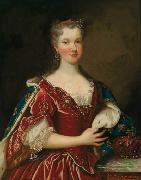 |
Alexis Simon Belle -- Click Here
|
|
(12 January 1674 - 21 November 1734) was a French portrait painter, known for his portraits of the French and Jacobite nobility.
Belle was born in Paris, the second child and only son of Jean-Baptiste Belle (born before 1642, died 1703), also a painter, and of Anne his wife (died 1705).
Belle's birth and baptism are recorded in the parish register of the church of Saint-Sulpice, Paris, and quoted in Eugene Piot's Le Cabinet de l'amateur for the years 1861 and 1862
|
|
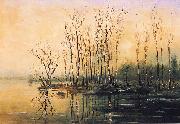 |
Alexej Kondratjewitsch Sawrassow -- Click Here
|
|
Alexei Kondratyevich Savrasov (Russian) (May 24, 1830 - October 8, 1897) was a Russian landscape painter and creator of the lyrical landscape style.
Savrasov was born into the family of a merchant. He began to draw early and in 1838 he enrolled as a student of professor Rabus at the Moscow School of Painting, Sculpture and Architecture (graduated in 1850), and immediately began to specialize in landscape painting.
In 1852, he traveled to Ukraine. Then, in 1854 by the invitation of the Grand Duchess Maria Nikolayevna, President of the Imperial Academy of Arts, he moved to the neighborhood of St. Petersburg. In 1857, Savrasov became a teacher at the Moscow School of painting, sculpturing and architecture. His best disciples, Isaac Levitan and Konstantin Korovin, remembered their teacher with admiration and gratitude.
|
|
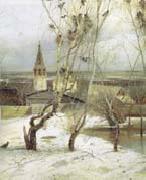 |
Alexei Savrasov -- Click Here
|
|
Russian Painter, 1830-1897
was a Russian landscape painter and creator of the lyrical landscape style. Savrasov was born into the family of a merchant. He began to draw early and in 1838 he enrolled as a student of professor Rabus at the Moscow School of Painting, Sculpture and Architecture (graduated in 1850), and immediately began to specialize in landscape painting. In 1852, he traveled to Ukraine. Then, in 1854 by the invitation of the Grand Duchess Maria Nikolayevna, President of the Imperial Academy of Arts, he moved to the neighborhood of St. Petersburg. In 1857, Savrasov became a teacher at the Moscow School of painting, sculpturing and architecture. His best disciples, Isaac Levitan and Konstantin Korovin, remembered their teacher with admiration and gratitude. The Rooks Have Come Back was painted by Savrasov near Ipatiev Monastery in Kostroma.In 1857, he married Sophia Karlovna Hertz, sister of art historian K. Hertz. In their home they entertained artistic people and collectors including Pavel Tretyakov. Savrasov became especially close with Vasily Perov. Perov helped him paint the figures of the boat trackers in Savrasov's Volga near Yuryevets, Savrasov painted landscapes for Perov's Bird catcher and Hunters on Bivouac. In the 1860s, he traveled to England to see the International Exhibition, and to Switzerland. In one of his letters he wrote that no academies in the world could so advance an artist as the present world exhibition. The painters who influenced him most were British painter John Constable and Swiss painter Alexandre Calame. The Rooks Have Come Back (1871) is considered by many critics to be the high point in Savrasoves artistic career. Using a common, even trivial, episode of birds returning home, and an extremely simple landscape, Savrasov emotionally showed the transition of nature from winter to spring. It was a new type of lyrical landscape painting, called later by critics the mood landscape. The painting brought him fame. In 1870, he became a member of the Peredvizhniki group, breaking with government-sponsored academic art. In 1871, |
|
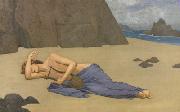 |
Alexandre Seon -- Click Here
|
|
French Symbolist Painter, 1855-1917
was a French Symbolist artist, illustrator and decorator. Seon studied at the Beaux-Arts of Lyon and Paris, becoming a student of Puvis de Chavannes in 1891, with whom he later collaborated. He was closely associated with Josephin Peladan and his Salon de la Rose-Croix, and designed the frontispiece for Peladan's 1891 novel l'Androgyne |
|
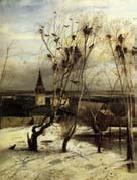 |
Aleksei Savrasov -- Click Here
|
|
Russian Painter , 1830-1897 |
|
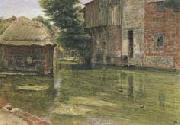 |
Albert Goodwin,RWS -- Click Here
|
|
1845-1932
English painter. During the early 1860s Goodwin studied with Arthur Hughes and Ford Madox Brown, who predicted that his pupil would become 'one of the greatest landscape painters of the age'. Hughes and Brown impressed on Goodwin the Pre-Raphaelite principles of high finish, vivid colour and working directly from nature that inform his early landscape style |
|
|
|
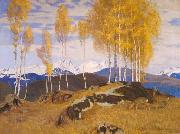 |
Adrian Scott Stokes -- Click Here
|
|
RA (1854-1935) was an English landscape painter. Born in Southport, Lancashire, he became a cotton broker in Liverpool, where his artistic talent was noticed by John Herbert RA, who advised him to submit his drawings to the Royal Academy. He entered the Royal Academy Schools in 1872 and exhibited at the Academy from 1876. In that year went to France where he lived for 10 years, settling back in England in 1886, at Carbis Bay and joining the artists' colony at St Ives.
Adrian Stokes was a landscape painter, concerned most with atmospheric effects, and later with decorative landscapes. He was the author of 'Landscape Painting' (1925). He became ARA in 1909 and RA in 1919, won medals at the Paris Exhibition and Chicago World Fair (1889), became first President of the St Ives Society of Arts (1890) and Vice President of the Royal Watercolour Society (1932).
He married Marianne Preindlesberger of Graz, Austria, in 1884, while living in France. She became a well known artist under her married name of Marianne Stokes. An obituary of Adrian Stokes was published in The Times Monday 2 December 1935
|
|
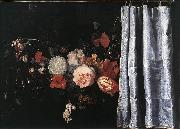 |
Adriaen van der Spelt -- Click Here
|
|
Adriaen van der Spelt (ca. 1630, Leiden - 1673, Gouda), was a Dutch Golden Age flower painter.
According to Houbraken, whose comments were based on the Gouda stories by Ignatius Walvis, he was an excellent flower painter born in Leiden, but his parentage was from Gouda. He spent many years at the court of Brandenburg working for Frederick William I, Elector of Brandenburg, but moved to Gouda to marry a third time with a nasty wife from Groningen who drove him to his grave.
According to the RKD he was a flower painter who spent the years 1664-1670 at the court of Brandenburg. |
|
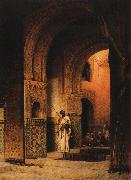 |
Adolf Steel -- Click Here
|
|
German, 1829 - 1907
German and lived in Germany.
Most of his works are about arab people and arabic street and city. There are a lot of oil paintings which are collected by museums in Europe. |
|
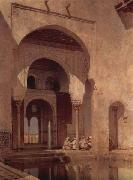 |
Adolf Seel -- Click Here
|
|
(1 March 1829-14 February 1907) was a German painter. He enjoyed training at the Dseldorf Academy of Arts.
Seel visited the academy in Dseldorf in 1844-50, where he trained under Wilhelm Sohn. He then continued to train one year in Paris, spent 1864 and 1865 in Italy, 1870 and 1871 Spain, Portugal and the north coast of Africa as well as 1873 and 1874 the Orient, where he developed his preference for the architecture painting found rich food. Its pieces of architecture, particularly the Arab and Moorish buildings, are usually provided just as beautiful landscapes painted with a masterful perspective, lighting and coloring.
|
|
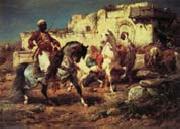 |
Adolf Schreyer -- Click Here
|
|
German Academic Painter, 1828-1899,German painter, was born at Frankfurt-am-Main. He studied art first at the Städel Institute in his native town, and then at Stuttgart and Munich. He painted many of his favourite subjects in his travels in the East. He first accompanied Prince Thurn and Taxis through Hungary, Wallachia, Russia and Turkey; then, in 1854, he followed the Austrian army across the Wallachian frontier. In 1856 he went to Egypt and Syria, and in 1861 to Algiers. In 1862 he settled in Paris, but returned to Germany in 1870; and settled at Cronberg near Frankfurt, where he died. Arab Horsemen by Schreyer.Schreyer was, and is still, especially esteemed as a painter of horses, of peasant life in Wallachia and Moldavia, and of battle incidents. His work is remarkable for its excellent equine draughtsmanship, and for the artist's power of observation and forceful statement; and has found particular favour among French and American collectors. Of his battle-pictures there are two at the Schwerin Gallery, and others in the collection of Count Mensdorff-Pouilly and in the Raven Gallery, Berlin. His painting of a Charge of Artillery of Imperial Guard was formerly at the Luxembourg Museum. The Metropolitan Museum, New York owns three of Schreyer's oriental paintings: Abandoned, Arabs on the March and Arabs making a detour; and many of his best pictures are in the Rockefeller family, Vanderbilt family, John Jacob Astor, William Backhouse Astor, Sr., August Belmont, and William Walters collections. |
|
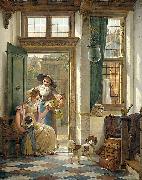 |
Abraham van Strij -- Click Here
|
|
painted Een kersenverkoopster aan de deur
in 1816 |
|
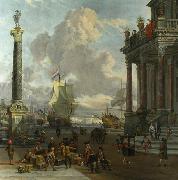 |
Abraham Storck -- Click Here
|
|
Abraham Storck (or Sturckenburch) (bapt. April 17, 1644 - buried April 8, 1708), was a Dutch landscape and maritime painter of the Baroque era.
Storck was born and died in Amsterdam, and came from a family of painters of the same name. He had a painter's studio in Amsterdam producing naval and harbor scenes as well as landscape paintings. He was influenced by the two Willem van de Veldes (the elder and the younger) and by Jan Abrahamsz Beerstraaten. |
|
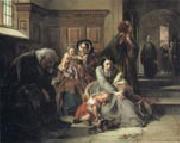 |
Abraham Solomon -- Click Here
|
|
English Painter, 1824-1862 |
|
|
|
|
|
|
| | |
|
|
|
|